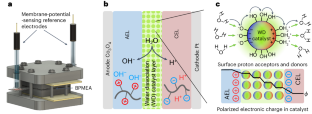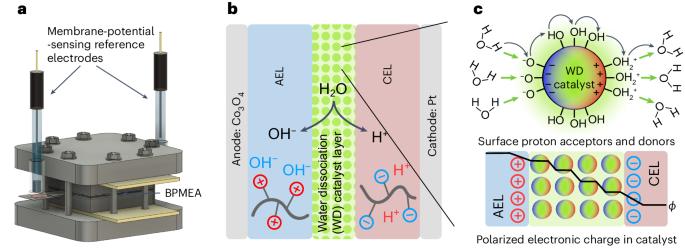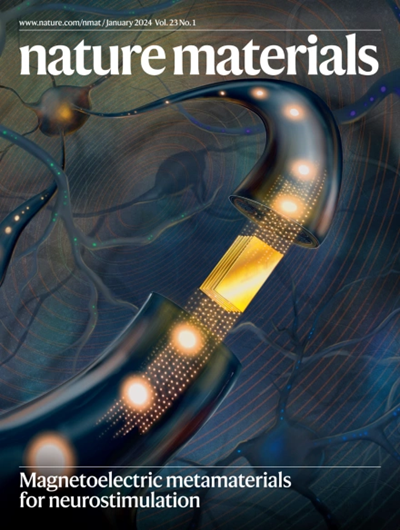Materials descriptors for advanced water dissociation catalysts in bipolar membranes
IF 37.2
1区 材料科学
Q1 CHEMISTRY, PHYSICAL
引用次数: 0
Abstract
The voltage penalty driving water dissociation (WD) at high current density is a major obstacle in the commercialization of bipolar membrane (BPM) technology for energy devices. Here we show that three materials descriptors, that is, electrical conductivity, microscopic surface area and (nominal) surface-hydroxyl coverage, effectively control the kinetics of WD in BPMs. Using these descriptors and optimizing mass loading, we design new earth-abundant WD catalysts based on nanoparticle SnO2 synthesized at low temperature with high conductivity and hydroxyl coverage. These catalysts exhibit exceptional performance in a BPM electrolyser with low WD overvoltage (ηwd) of 100 ± 20 mV at 1.0 A cm−2. The new catalyst works equivalently well with hydrocarbon proton-exchange layers as it does with fluorocarbon-based Nafion, thus providing pathways to commercializing advanced BPMs for a broad array of electrolysis, fuel-cell and electrodialysis applications. The voltage penalty driving water dissociation at high current density is a challenge for bipolar-membrane-based energy devices. Materials descriptors such as electrical conductivity, microscopic surface area and surface-hydroxyl coverage are now shown to control water dissociation kinetics in these membranes.


双极膜先进水解离催化剂的材料描述符
在高电流密度下驱动水解离(WD)的电压惩罚是能源设备双极膜(BPM)技术商业化的主要障碍。在这里,我们展示了三种材料描述因子,即导电性、微观表面积和(名义)表面羟基覆盖率,它们能有效控制双极膜中水解离的动力学。利用这些描述因子并优化质量负载,我们设计出了基于在低温下合成的具有高导电性和羟基覆盖率的纳米二氧化锡的新型富土 WD 催化剂。这些催化剂在 BPM 电解槽中表现出卓越的性能,在 1.0 A cm-2 的条件下,WD 过电压 (ηwd) 低至 100 ± 20 mV。这种新型催化剂在碳氢化合物质子交换层和碳氟化合物基 Nafion 中的效果相当,从而为电解、燃料电池和电渗析等广泛应用提供了先进 BPM 商业化的途径。
本文章由计算机程序翻译,如有差异,请以英文原文为准。
求助全文
约1分钟内获得全文
求助全文
来源期刊

Nature Materials
工程技术-材料科学:综合
CiteScore
62.20
自引率
0.70%
发文量
221
审稿时长
3.2 months
期刊介绍:
Nature Materials is a monthly multi-disciplinary journal aimed at bringing together cutting-edge research across the entire spectrum of materials science and engineering. It covers all applied and fundamental aspects of the synthesis/processing, structure/composition, properties, and performance of materials. The journal recognizes that materials research has an increasing impact on classical disciplines such as physics, chemistry, and biology.
Additionally, Nature Materials provides a forum for the development of a common identity among materials scientists and encourages interdisciplinary collaboration. It takes an integrated and balanced approach to all areas of materials research, fostering the exchange of ideas between scientists involved in different disciplines.
Nature Materials is an invaluable resource for scientists in academia and industry who are active in discovering and developing materials and materials-related concepts. It offers engaging and informative papers of exceptional significance and quality, with the aim of influencing the development of society in the future.
 求助内容:
求助内容: 应助结果提醒方式:
应助结果提醒方式:


